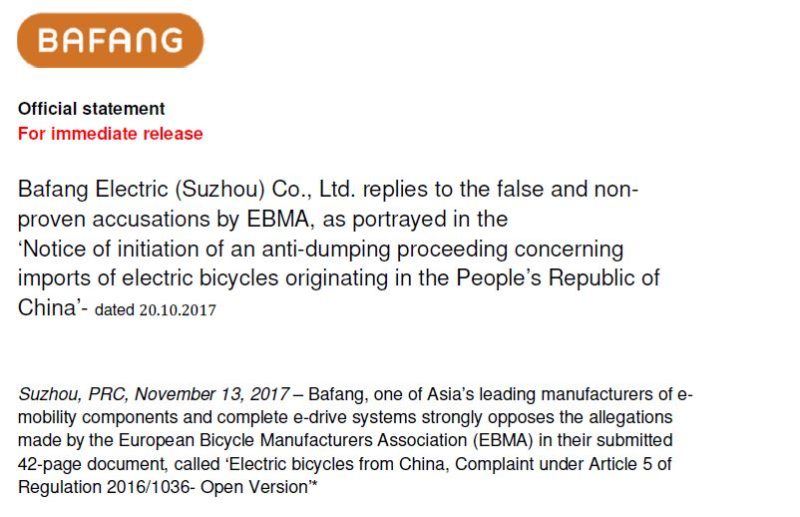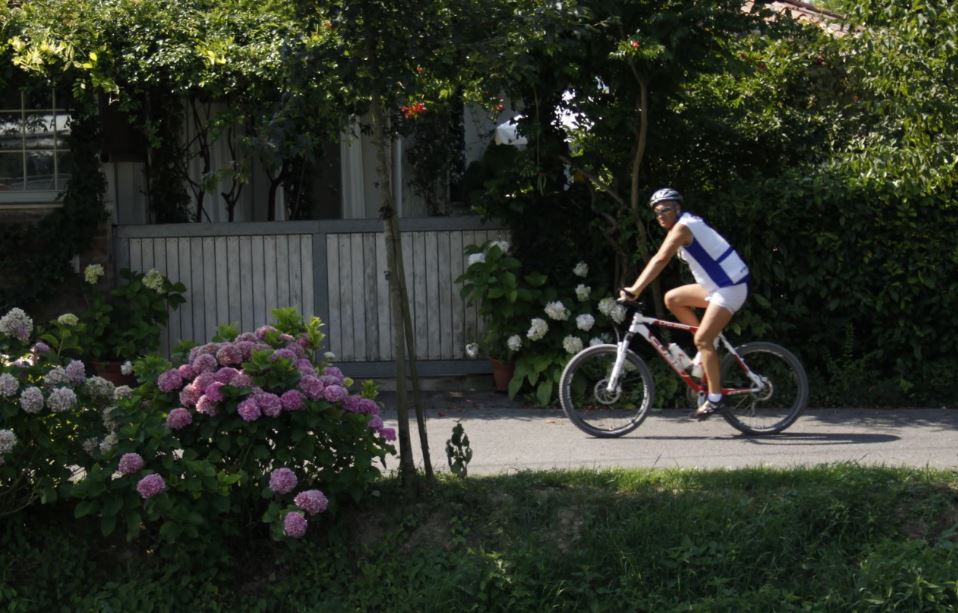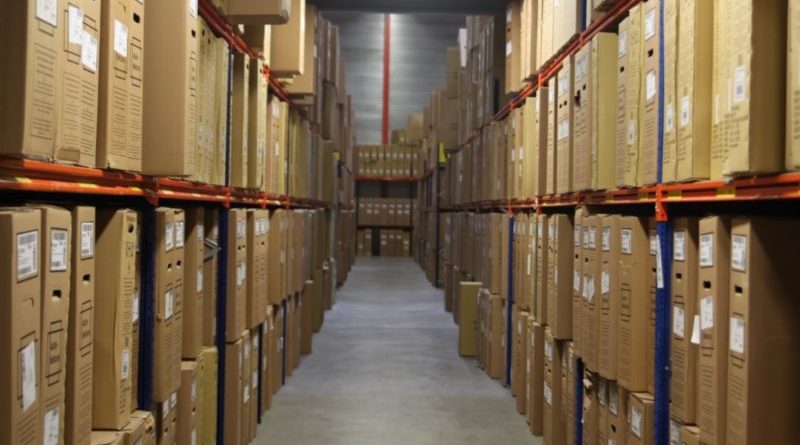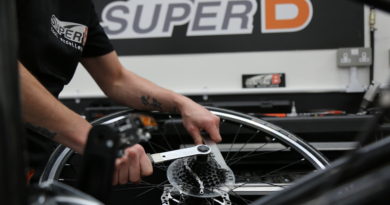China counters EBMA anti-dumping evidence with own investigation, Bafang wades in
Various organisations like the Chinese Chamber of Commerce for Import and Export of Machinery and Electronic Products are to issue an in-depth response to the European Bicycle Manufacturer’s Association, which has recently submitted an anti-dumping complaint against imports into the EU, citing a deep concern on the impact on European e-Bike makers.

Bafang is one such manufacturer directly involved and the motor maker has now issued an open letter, which can now be read in full here.
Within Bafang strongly condemns segments of the EBMA’s evidence against it, among other suppliers in the region.
“The indictment from the European Bicycle Manufacturer’s Association (EBMA) has several accusations without any proof that Bafang received heavy government subsidies and with that, eBikes were allegedly ‘dumped’ into the European market,” says Bafang on its part in the dispute. “Besides many other wrong and constructed arguments in the paper, it proves that EBMA has an incomplete, distorted and biased understanding on the history of the development of electric power-assisted bicycle and the Chinese eBike industry.”
The to an fro between China and the EBMA has a deep history, but with significant investment placed in the electric bike industry on both sides of the globe, the arguments have re-ignited in spectacular fashion. Electric bikes are, at the present time, an increasingly rare money spinner for the bicycle business. With over €1 billion invested by the EU bike business into electric bike production in 2015 alone, the EBMA’s complaint seeks to protect European jobs, as well as promote reshoring of production to grow domestic markets.
Welcoming an EU investigation, EBMA secretary general Moreno Fioravanti recently said: “(The) EBMA and the EU manufacturers of bicycles, pedal assist e-bikes, and components are firm believers in free trade, but trade must also be fair. Injuring domestic producers through imports which are dumped and heavily government-subsidised is against the WTO rules. We have asked the Commission to order the registration of Chinese e-bikes as soon as possible so that the blatant disregard of trade rules by Chinese e-bike manufacturers can be stopped quickly.”
Countering the complaint, China’s reply letter will segment the argument into reasons it believes that it is competing on a level playing field. Among those arguments the letter outlines that cheaper e-Bikes don’t necessarily mean they are made by unfair means. 
Among those examples highlighted, direct-to-consumer sales evolution, lower labour costs in the far-east and indeed China’s increasingly advanced production methods are cited as just a handful of reasons why manufacturers are shipping bikes at such a competitive price.
Quoting the document submitted to the EU by EBMA, China counters a claim that electric bikes are a European invention and one therefore the business is entitled to defend. The EBMA’s stance, says the opening of China’s argument, suggests that Bosch, a global market leader in drive systems, “revolutionised the e-Bike industry with its first centre engine in 2010.”
Contrary to that point, China points to Yamaha and Panasonic’s early electric bikes, put into the market as far back as 1995. Yamaha’s electric bike product, including mid-motor designs, stemmed from Japan.
Another point relates to a claim that Chinese makers received Government subsidy. Contrary to that claim, the it’s been pointed out that “the electric bicycle industry is a traditional industry in China, not an industry encouraged by the state. The government has not given any subsidy.”
It further claims that the major Chinese drive system manufacturer Bafang did not get any government subsidies to help drive China’s acceleration on the global stage. Indeed China and Taiwan haven’t always been kind to electric bikes in recent times, moving to enforce licences on riders, among other actions.
China will claim that, of those the e-Bikes bikes sold into the global market, its are not always among the cheapest. In its retort, it points to selected French and German bikes that are achieving lowered retail prices by skipping the IBD channel, instead sold via online sellers, mass market sellers and mail order channels.
Growth in exports from China did jump to 1.3 million units in 2016, totaling USD $510 million, a 20% rise. The EBMA has seized upon this as a cause for alarm, with Fioravanti warning of the “annihilation” of the EU industry, should the export growth continue.
China disputes the assumption that such growth is inevitable to continue and has called for evidence to support figures it claims are extrapolated out of context.

The occasionally complex problem has many off-shoots, one relating to the shipping of pedal bicycles from China – and thus subject to a 48.5% dumping duty. It is acknowledged that there have been cases where pedal bicycles have been shipped using codes linked to electric bikes, currently subject to a 6% import duty. This, it is said, is achieved by adding components that may appear electrical in nature, such as dynamo hubs or battery-powered lighting. Of course not all bikes can be checked in great detail when landing at ports. It is further suggested that this could contribute as a reason for the much lower overall value of imported bikes under the e-Bike import code.
Spec choice also features in China’s counter argument. In the EU mid-motors have become dominant. In China, while the market is moving in the direction of mid-motors, there is a much wider use of alternatives that are cheaper by nature. Furthermore, China points to the locality of major cell suppliers – Samsung, Panasonic and Sony – as another reason why Chinese bikes are able to be delivered at a naturally lower cost.
Toward the tail end of China’s retort is a claim that the European Commission and EBMA’s notices don’t go into detail on average pricing. Both papers skirt this in favour of focusing on growth of exports and estimates on China’s production capabilities. The response is also to flag that Asian businesses, such as Fritz Jou, have invested in European production.
China will ask in its response for proof of much of the above and will call on the EU to investigate in depth the data supplied by both parties. In particular, those making the complaints will seek data-driven proof of its market share impact on the EU, including proof that its imports have suppressed growth of EU labels.
World Trade Organisation rules enable dumping duties to be imposed on products from third countries if an investigation, such as that proposed at present, can demonstrate that products enter at “dumped prices” and thus causing injury to a domestic industry. Dumping is calculated by comparing the export price of a product to the EU with the domestic prices, or costs, of the product in the exporting country.



